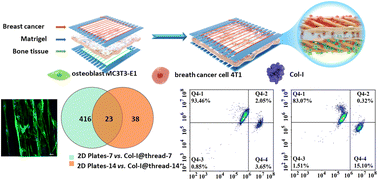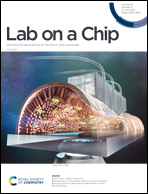Probing the interaction between metastatic breast cancer cells and osteoblasts in a thread-based breast–bone co-culture device†
Abstract
Breast cancer metastasis to bone is a leading killer in breast cancer patients. A type I collagen-modified thread (Col-I@thread) was prepared for 3-dimensional cell culture and breast cancer bone metastasis co-culture device assembly. First, the coating of Col-I on nylon threads for promoting cell adhesion and growth was studied. Through SEM, XPS, and protein concentration measurements, it was found that the lyophilization method remarkably preserved the Col-I activity and the internal structure of the thread, thereby promoting cell attachment and proliferation. RNA-sequencing (RNA-Seq) and quantitative PCR analysis showed that osteoblast cells (MC3T3-E1) grown on Col-I@thread had elevated RUNX2, ALP, OPN, and Col-I gene expression to promote osteoblast differentiation. Single-cell analysis found that osteoblast MC3T3-E1 cells growing on Col-I@thread had higher Ca2+ secretion activity and mineralized nodules, suggesting robust cell activity and bone matrix formation than cells growing on 2D culture plates. Col-I@threads were knotted in an interdigital cross-finger frame to assemble the breast cancer–bone co-culture model. Confocal microscopy and flow cytometry tests quantified the invasive breast cancer cells. Moreover, the thread-based co-culture devices allowed us to isolate the invasive and non-invasive breast cancer cells to compare their molecular characteristics. qPCR results showed that expression of CX43, CXCR5, and CSPG4 genes was significantly increased in breast cancer cells with bone metastasis. Meanwhile, the expression of RUNX2 and OPG genes in osteoblasts was inhibited. The co-culture model based on the Col-I@thread mimics the bone tissue microenvironment to reveal the cross-talk between cancer cells and bone tissue. Moreover, the thread-based co-culture device is easy to fabricate and operate, providing a platform for exploring the cellular and molecular mechanisms of breast cancer bone metastasis, and holds potential for high-throughput screening of anti-breast cancer bone metastasis drugs.



 Please wait while we load your content...
Please wait while we load your content...